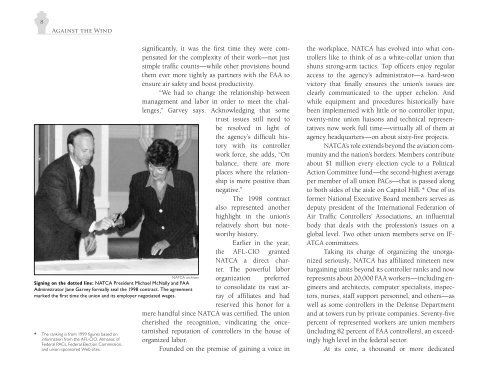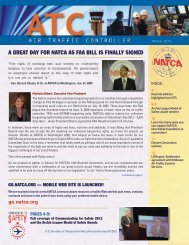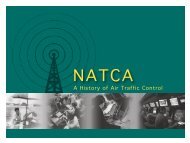Against the Wind - National Air Traffic Controllers Association
Against the Wind - National Air Traffic Controllers Association
Against the Wind - National Air Traffic Controllers Association
You also want an ePaper? Increase the reach of your titles
YUMPU automatically turns print PDFs into web optimized ePapers that Google loves.
8<br />
<strong>Against</strong> <strong>the</strong> <strong>Wind</strong><br />
NATCA archives<br />
Signing on <strong>the</strong> dotted line: NATCA President Michael McNally and FAA<br />
Administrator Jane Garvey formally seal <strong>the</strong> 1998 contract. The agreement<br />
marked <strong>the</strong> first time <strong>the</strong> union and its employer negotiated wages.<br />
* The ranking is from 1999 figures based on<br />
information from <strong>the</strong> AFL-CIO, Almanac of<br />
Federal PACs, Federal Election Commission,<br />
and union-sponsored Web sites.<br />
significantly, it was <strong>the</strong> first time <strong>the</strong>y were compensated<br />
for <strong>the</strong> complexity of <strong>the</strong>ir work—not just<br />
simple traffic counts—while o<strong>the</strong>r provisions bound<br />
<strong>the</strong>m ever more tightly as partners with <strong>the</strong> FAA to<br />
ensure air safety and boost productivity.<br />
“We had to change <strong>the</strong> relationship between<br />
management and labor in order to meet <strong>the</strong> challenges,”<br />
Garvey says. Acknowledging that some<br />
trust issues still need to<br />
be resolved in light of<br />
<strong>the</strong> agency’s difficult history<br />
with its controller<br />
work force, she adds, “On<br />
balance, <strong>the</strong>re are more<br />
places where <strong>the</strong> relationship<br />
is more positive than<br />
negative.”<br />
The 1998 contract<br />
also represented ano<strong>the</strong>r<br />
highlight in <strong>the</strong> union’s<br />
relatively short but noteworthy<br />
history.<br />
Earlier in <strong>the</strong> year,<br />
<strong>the</strong> AFL-CIO granted<br />
NATCA a direct charter.<br />
The powerful labor<br />
organization preferred<br />
to consolidate its vast array<br />
of affiliates and had<br />
reserved this honor for a<br />
mere handful since NATCA was certified. The union<br />
cherished <strong>the</strong> recognition, vindicating <strong>the</strong> oncetarnished<br />
reputation of controllers in <strong>the</strong> house of<br />
organized labor.<br />
Founded on <strong>the</strong> premise of gaining a voice in<br />
<strong>the</strong> workplace, NATCA has evolved into what controllers<br />
like to think of as a white-collar union that<br />
shuns strong-arm tactics. Top officers enjoy regular<br />
access to <strong>the</strong> agency’s administrator—a hard-won<br />
victory that finally ensures <strong>the</strong> union’s issues are<br />
clearly communicated to <strong>the</strong> upper echelon. And<br />
while equipment and procedures historically have<br />
been implemented with little or no controller input,<br />
twenty-nine union liaisons and technical representatives<br />
now work full time—virtually all of <strong>the</strong>m at<br />
agency headquarters—on about sixty-five projects.<br />
NATCA’s role extends beyond <strong>the</strong> aviation community<br />
and <strong>the</strong> nation’s borders. Members contribute<br />
about $1 million every election cycle to a Political<br />
Action Committee fund—<strong>the</strong> second-highest average<br />
per member of all union PACs—that is passed along<br />
to both sides of <strong>the</strong> aisle on Capitol Hill. * One of its<br />
former <strong>National</strong> Executive Board members serves as<br />
deputy president of <strong>the</strong> International Federation of<br />
<strong>Air</strong> <strong>Traffic</strong> <strong>Controllers</strong>’ <strong>Association</strong>s, an influential<br />
body that deals with <strong>the</strong> profession’s issues on a<br />
global level. Two o<strong>the</strong>r union members serve on IF-<br />
ATCA committees.<br />
Taking its charge of organizing <strong>the</strong> unorganized<br />
seriously, NATCA has affiliated nineteen new<br />
bargaining units beyond its controller ranks and now<br />
represents about 20,000 FAA workers—including engineers<br />
and architects, computer specialists, inspectors,<br />
nurses, staff support personnel, and o<strong>the</strong>rs—as<br />
well as some controllers in <strong>the</strong> Defense Department<br />
and at towers run by private companies. Seventy-five<br />
percent of represented workers are union members<br />
(including 82 percent of FAA controllers), an exceedingly<br />
high level in <strong>the</strong> federal sector.<br />
At its core, a thousand or more dedicated




